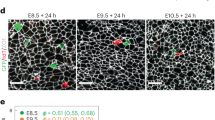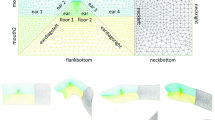Abstract
Morphogenesis is regulated by genetic, biochemical, and biomechanical factors, but the feedback controlling the interactions between these factors remains poorly understood. A previous study has found that compressing the brain tube of the early chick embryo induces changes in contractility and nuclear shape in the neuroepithelial wall. Assuming this response involves mechanical feedback, we used experiments and computational modeling to investigate a hypothetical mechanism behind the observed behavior. First, we measured nuclear circularity in embryonic chick brains subjected to transverse compression. Immediately after loading, the circularity varied regionally and appeared to reflect the local state of stress in the wall. After three hours of culture with sustained compression, however, the nuclei became rounder. Exposure to a gap junction blocker inhibited this response, suggesting that it requires intercellular diffusion of a biochemical signal. We speculate that the signal regulates the contraction that occurs near the lumen, altering stress distributions and nuclear geometry throughout the wall. Simulating compression using a chemomechanical finite-element model based on this idea shows that our hypothesis is consistent with most of the experimental data. This work provides a foundation for future investigations of chemomechanical feedback in epithelia during embryonic development.











Similar content being viewed by others
Data availability
Detailed images and measurements will be furnished on reasonable request.
Code availability
Comsol models will be provided on request.
References
Beloussov, L.V.: Morphomechanics of Development, vol. 955. Springer, Berlin (2015)
Lecuit, T., Lenne, P.F., Munro, E.: Force generation, transmission, and integration during cell and tissue morphogenesis. Annu. Rev. Cell Dev. Biol. 27, 157–184 (2011). https://doi.org/10.1146/annurev-cellbio-100109-104027
Hannezo, E., Heisenberg, C.-P.: Mechanochemical feedback loops in development and disease. Cell 178(1), 12–25 (2019)
Mammoto, T., Mammoto, A., Ingber, D.E.: Mechanobiology and developmental control. Annu. Rev. Cell Dev. Biol. 29, 27–61 (2013)
Merle, T., Farge, E.: Trans-scale mechanotransductive cascade of biochemical and biomechanical patterning in embryonic development: the light side of the force. Curr. Opin. Cell Biol. 55, 111–118 (2018). https://doi.org/10.1016/j.ceb.2018.07.003
Filas, B.A., Oltean, A., Beebe, D.C., Okamoto, R.J., Bayly, P.V., Taber, L.A.: A potential role for differential contractility in early brain development and evolution. Biomech. Model. Mechanobiol. 11(8), 1251–1262 (2012). https://doi.org/10.1007/s10237-012-0389-4
Hosseini, H.S., Garcia, K.E., Taber, L.A.: A new hypothesis for foregut and heart tube formation based on differential growth and actomyosin contraction. Development 144(13), 2381–2391 (2017). https://doi.org/10.1242/dev.145193
Kim, H.Y., Varner, V.D., Nelson, C.M.: Apical constriction initiates new bud formation during monopodial branching of the embryonic chicken lung. Development 140(15), 3146–3155 (2013). https://doi.org/10.1242/dev.093682
Gorfinkiel, N., Blanchard, G.B.: Dynamics of actomyosin contractile activity during epithelial morphogenesis. Curr. Opin. Cell Biol. 23(5), 531–539 (2011)
Heer, N.C., Martin, A.C.: Tension, contraction and tissue morphogenesis. Development 144(23), 4249–4260 (2017)
Filas, B.A., Bayly, P.V., Taber, L.A.: Mechanical stress as a regulator of cytoskeletal contractility and nuclear shape in embryonic epithelia. Ann. Biomed. Eng. 39, 443–454 (2011). https://doi.org/10.1007/s10439-010-0171-7
Lecuit, T., Lenne, P.F.: Cell surface mechanics and the control of cell shape, tissue patterns and morphogenesis. Nat. Rev. Mol. Cell Biol. 8(8), 633–644 (2007). https://doi.org/10.1038/nrm2222
Hamburger, V., Hamilton, H.L.: A series of normal stages in the development of the chick embryo. J. Morphol. 88, 49–92 (1951)
Voronov, D.A., Taber, L.A.: Cardiac looping in experimental conditions: effects of extraembryonic forces. Dev. Dyn. 224(4), 413–421 (2002). https://doi.org/10.1002/dvdy.10121
Damania, D., Subramanian, H., Tiwari, A.K., Stypula, Y., Kunte, D., Pradhan, P., Roy, H.K., Backman, V.: Role of cytoskeleton in controlling the disorder strength of cellular nanoscale architecture. Biophys. J. 99(3), 989–996 (2010)
Sullivan, G.M., Feinn, R.: Using effect size – or why the p value is not enough. J. Grad. Med. Educ. 4(3), 279–282 (2012)
Abbaci, M., Barberi-Heyob, M., Blondel, W., Guillemin, F., Didelon, J.: Advantages and limitations of commonly used methods to assay the molecular permeability of gap junctional intercellular communication. BioTechniques 45(1), 33–62 (2008)
Tojkander, S., Gateva, G., Lappalainen, P.: Actin stress fibers - assembly, dynamics and biological roles. J. Cell Sci. 125(Pt 8), 1855–1864 (2012). https://doi.org/10.1242/jcs.098087
Katoh, K., Kano, Y., Noda, Y.: Rho-associated kinase-dependent contraction of stress fibres and the organization of focal adhesions. J. R. Soc. Interface 8(56), 305–311 (2011)
Thomas, C.H., Collier, J.H., Sfeir, C.S., Healy, K.E.: Engineering gene expression and protein synthesis by modulation of nuclear shape. Proc. Natl. Acad. Sci. USA 99(4), 1972–1977 (2002). https://doi.org/10.1073/pnas.032668799. 032668799 [pii]
Rodriguez, E.K., Hoger, A., McCulloch, A.D.: Stress-dependent finite growth in soft elastic tissues. J. Biomech. 27(4), 455–467 (1994)
Taber, L.A.: Continuum Modeling in Mechanobiology. Springer, Berlin (2020)
Taber, L.A.: Nonlinear Theory of Elasticity: Applications in Biomechanics. World Scientific, New Jersey (2004)
Hosseini, H.S., Beebe, D.C., Taber, L.A.: Mechanical effects of the surface ectoderm on optic vesicle morphogenesis in the chick embryo. J. Biomech. 47(16), 3837–3846 (2014). https://doi.org/10.1016/j.jbiomech.2014.10.018
Xu, G., Kemp, P.S., Hwu, J.A., Beagley, A.M., Bayly, P.V., Taber, L.A.: Opening angles and material properties of the early embryonic chick brain. J. Biomech. Eng. 132(1), 011005 (2010). https://doi.org/10.1115/1.4000169
Blatz, P.D., Ko, W.L.: Application of finite elasticity to the deformation of rubbery materials. Trans. Soc. Rheol. 6, 223–251 (1962)
Pajerowski, J.D., Dahl, K.N., Zhong, F.L., Sammak, P.J., Discher, D.E.: Physical plasticity of the nucleus in stem cell differentiation. Proc. Natl. Acad. Sci. USA 104(40), 15619–15624 (2007). https://doi.org/10.1073/pnas.0702576104
Pathak, A., McMeeking, R.M., Evans, A.G., Deshpande, V.S.: An analysis of the cooperative mechano-sensitive feedback between intracellular signaling, focal adhesion development, and stress fiber contractility. J. Appl. Mech. 78(4), 041001 (2011)
Wang, Q., Feng, J.J., Pismen, L.M.: A cell-level biomechanical model of Drosophila dorsal closure. Biophys. J. 103(11), 2265–2274 (2012)
Thompson, D.W.: On Growth and Form. Cambridge University Press, Cambridge (1942)
Turing, A.M.: The chemical basis of morphogenesis. Philos. Trans. R. Soc. Lond. B 237, 37–72 (1952)
Wolpert, L.: Positional information and the spatial pattern of cellular differentiation. J. Theor. Biol. 25(1), 1–47 (1969). https://doi.org/10.1016/s0022-5193(69)80016-0
Green, J.B., Sharpe, J.: Positional information and reaction-diffusion: two big ideas in developmental biology combine. Development 142(7), 1203–1211 (2015)
Beloussov, L.V.: The Dynamic Architecture of a Developing Organism: An Interdisciplinary Approach to the Development of Organisms. Kluwer Academic, Dordrecht (1998)
Beloussov, L.V., Lipchinsky, A.: Morphomechanics of Development. Springer, New York (2015)
Pouille, P.A., Ahmadi, P., Brunet, A.C., Farge, E.: Mechanical signals trigger myosin II redistribution and mesoderm invagination in Drosophila embryos. Sci. Signal. 2(66), ra16 (2009). https://doi.org/10.1126/scisignal.2000098
Goodenough, D.A., Paul, D.L.: Gap junctions. Cold Spring Harb. Perspect. Biol. 1(1), a002576 (2009)
Ponik, S.M., Trier, S.M., Wozniak, M.A., Eliceiri, K.W., Keely, P.J.: RhoA is down-regulated at cell–cell contacts via p190rhogap-b in response to tensional homeostasis. Mol. Biol. Cell 24(11), 1688–1699 (2013)
Acharya, B.R., Nestor-Bergmann, A., Liang, X., Gupta, S., Duszyc, K., Gauquelin, E., Gomez, G.A., Budnar, S., Marcq, P., Jensen, O.E., Bryant, Z., Yap, A.S.: A mechanosensitive RhoA pathway that protects epithelia against acute tensile stress. Dev. Cell 47(4), 439–452 (2018)
Szczesny, S.E., Mauck, R.L.: The nuclear option: evidence implicating the cell nucleus in mechanotransduction. J. Biomech. Eng. 139(2), 021006 (2017). https://doi.org/10.1115/1.4035350
Kirby, T.J., Lammerding, J.: Emerging views of the nucleus as a cellular mechanosensor. Nat. Cell Biol. 20(4), 373–381 (2018)
Odell, G.M., Oster, G., Alberch, P., Burnside, B.: The mechanical basis of morphogenesis. I. Epithelial folding and invagination. Dev. Biol. 85(2), 446–462 (1981)
Olesen, N.E., Hofgaard, J.P., Holstein-Rathlou, N.-H., Nielsen, M.S., Jacobsen, J.C.B.: Estimation of the effective intercellular diffusion coefficient in cell monolayers coupled by gap junctions. Eur. J. Pharm. Sci. 46(4), 222–232 (2012)
Deshpande, V.S., Mrksich, M., McMeeking, R.M., Evans, A.G.: A bio-mechanical model for coupling cell contractility with focal adhesion formation. J. Mech. Phys. Solids 56(4), 1484–1510 (2008)
Ronan, W., Deshpande, V.S., McMeeking, R.M., McGarry, J.P.: Cellular contractility and substrate elasticity: a numerical investigation of the actin cytoskeleton and cell adhesion. Biomech. Model. Mechanobiol. 13(2), 417–435 (2014)
Maraldi, M., Garikipati, K.: The mechanochemistry of cytoskeletal force generation. Biomech. Model. Mechanobiol. 14(1), 59–72 (2015)
Acknowledgements
This paper is a tribute to Professor Gerhard Holzapfel to mark his 60th birthday. For five years, the second author (LAT) had the honor of serving alongside Professor Holzapfel as a co-Editor-in-Chief of Biomechanics and Modeling in Mechanobiology, the foremost journal in the burgeoning field of mechanobiology. With Jay Humphrey, Gerhard founded BMMB two decades ago and remains in his position today. It is a remarkable achievement that he can maintain the outstanding quality of the journal for so long while continuing to teach and run a vigorous research program at the same time. He truly has earned my utmost respect. We thank the Department of Mechanical Engineering & Materials Science at Washington University for use of the confocal microscope. This research was supported by Grant R01 NS070918 (LAT) from the National Institutes of Health.
Funding
Grant R01 NS070918 from the National Institutes of Health.
Author information
Authors and Affiliations
Corresponding author
Ethics declarations
Conflict of interest
None.
Competing interests
None.
Additional information
Publisher’s Note
Springer Nature remains neutral with regard to jurisdictional claims in published maps and institutional affiliations.
Supplementary Information
Below is the link to the electronic supplementary material.
Rights and permissions
About this article
Cite this article
Oltean, A., Taber, L.A. A Chemomechanical Model for Regulation of Contractility in the Embryonic Brain Tube. J Elast 145, 77–98 (2021). https://doi.org/10.1007/s10659-020-09811-7
Received:
Accepted:
Published:
Issue Date:
DOI: https://doi.org/10.1007/s10659-020-09811-7




